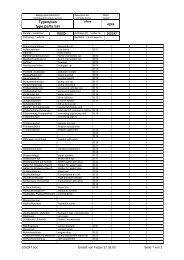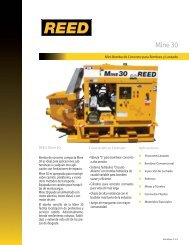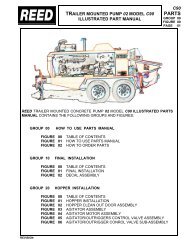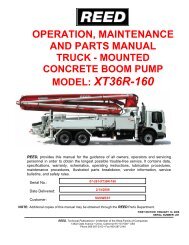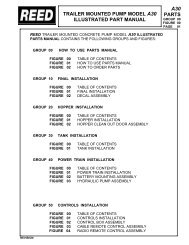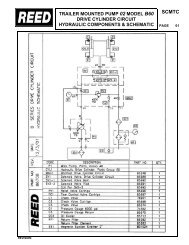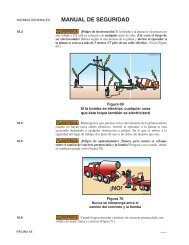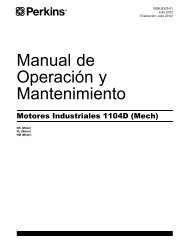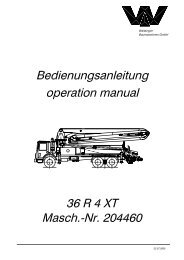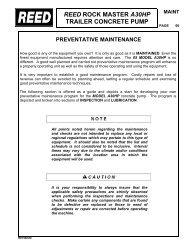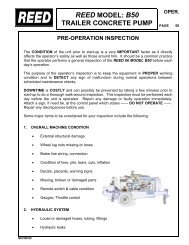Perkins Motor Operation and Maintenance Manual (English) - REED
Perkins Motor Operation and Maintenance Manual (English) - REED
Perkins Motor Operation and Maintenance Manual (English) - REED
You also want an ePaper? Increase the reach of your titles
YUMPU automatically turns print PDFs into web optimized ePapers that Google loves.
SEBU8325-01 25<br />
<strong>Operation</strong> Section<br />
Engine Starting<br />
Starting the Engine<br />
i02678840<br />
Note: If it is possible, first diagnose the reason for the<br />
starting failure. Make any necessary repairs. If the<br />
engine will not start only due to the condition of the<br />
battery, either charge the battery, or start the engine<br />
with jump start cables.<br />
The condition of the battery can be rechecked after<br />
the engine has beenswitchedOFF.<br />
Do not use aerosol types of starting aids such as<br />
ether. Such use could result in an explosion <strong>and</strong><br />
personal injury.<br />
Refer to the OEM for your type of controls. Use the<br />
following procedure to start the engine.<br />
1. If equipped, move the throttle lever to the full<br />
throttle position before you start the engine.<br />
NOTICE<br />
Do not crank the engine for more than 30 seconds.<br />
Allow the electric starting motor to cool for two minutes<br />
before cranking the engine again.<br />
2. Turn the engine start switch to the START position.<br />
Hold the engine start switch in the START position<br />
<strong>and</strong> crank the engine.<br />
3. When the engine starts, release the engine start<br />
switch.<br />
4. If equipped, slowly move the throttle lever to the<br />
low idle position <strong>and</strong> allow the engine to idle. Refer<br />
to the <strong>Operation</strong> <strong>and</strong> <strong>Maintenance</strong> <strong>Manual</strong>, “After<br />
Starting Engine” topic.<br />
5. If the engine does not start, release the engine<br />
start switch <strong>and</strong> allow the electric starting motor to<br />
cool. Then, repeat steps 2 through step 4.<br />
6. Turn the engine start switch to the OFF position in<br />
order to stop the engine.<br />
Starting with Jump Start<br />
Cables<br />
i02678837<br />
Improper jump start cable connections can cause<br />
an explosion resulting in personal injury.<br />
Prevent sparks near the batteries. Sparks could<br />
cause vapors to explode. Do not allow jump start<br />
cable ends to contact each other or the engine.<br />
NOTICE<br />
Using a battery source with the same voltage as the<br />
electric starting motor. Use ONLY equal voltage for<br />
jump starting. The use of higher voltage will damage<br />
the electrical system.<br />
Do not reverse the battery cables. The alternator can<br />
be damaged. Attach ground cable last <strong>and</strong> remove<br />
first.<br />
When using an external electrical source to start the<br />
engine, turn the generator set control switch to the<br />
“OFF” position. Turn all electrical accessories OFF before<br />
attaching the jump start cables.<br />
Ensure that the main power switch is in the OFF position<br />
before attaching the jump start cables to the engine<br />
being started.<br />
1. Turn the start switch to the OFF position. Turn off<br />
all the engine's accessories.<br />
2. Connect one positive end of the jump start cable<br />
to the positive cable terminal of the discharged<br />
battery. Connect the other positive end of the jump<br />
start cable to the positive cable terminal of the<br />
electrical source.<br />
3. Connect one negative end of the jump start cable<br />
to the negative cable terminal of the electrical<br />
source. Connect the other negative end of the<br />
jump start cable to the engine block or to the<br />
chassis ground. This procedure helps to prevent<br />
potential sparks from igniting the combustible<br />
gases that are produced by some batteries.<br />
4. Start the engine.<br />
5. Immediately after the stalled engine is started,<br />
disconnect the jump start cables in reverse order.<br />
After jump starting, the alternator may not be able to<br />
fully recharge batteries that are severely discharged.<br />
The batteries must be replaced or charged to the<br />
correct voltage with a battery charger after the engine<br />
is stopped. Many batteries which are considered<br />
unusable are still rechargeable. Refer to <strong>Operation</strong><br />
<strong>and</strong> <strong>Maintenance</strong> <strong>Manual</strong>, “Battery - Replace” <strong>and</strong><br />
Testing <strong>and</strong> Adjusting <strong>Manual</strong>, “Battery - Test”.



